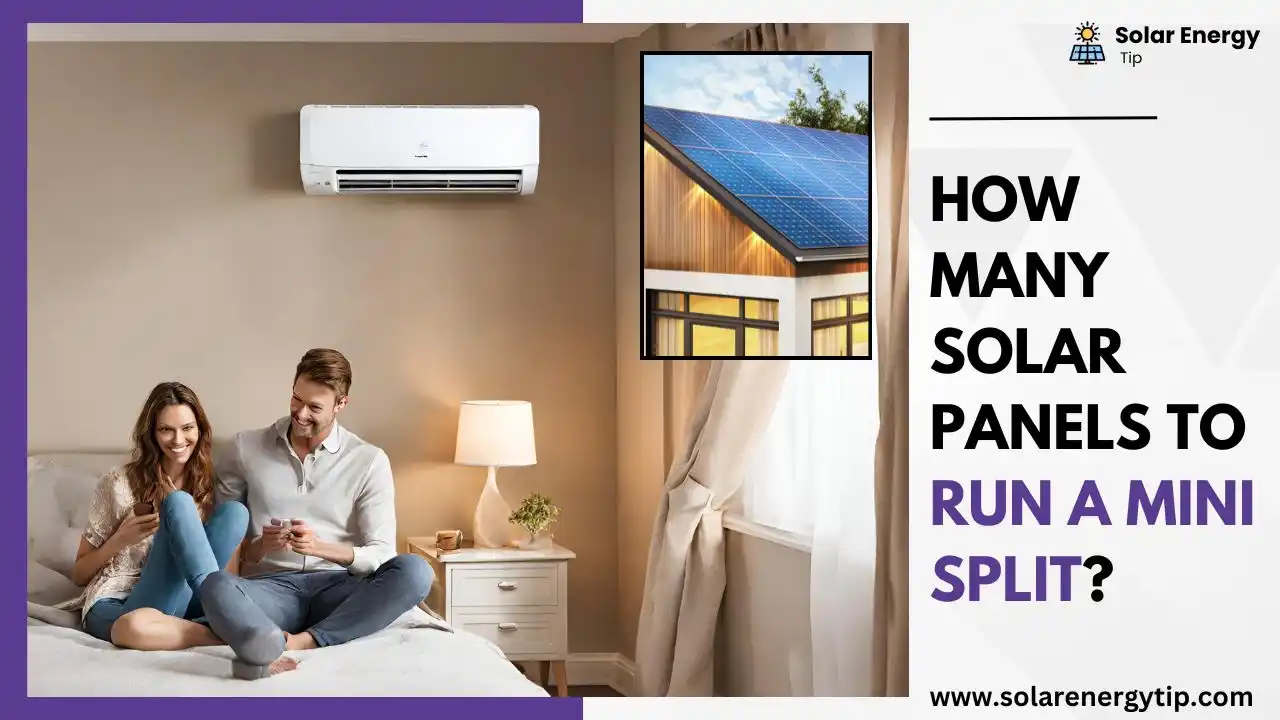Are you tired of high electricity expenses for your mini-split system? and you decide to install solar panels for your mini-split.
So, you reached a perfect place to know how many solar panels to run a mini split.
Here, I suggest some calculations and processes to know the required solar panels for mini AC
The number of solar panels needed depends on your mini split’s size, energy demand, and efficiency.
The number of solar panels needed depends on your mini split’s size, energy demand, and efficiency.
After reading this post, you’ll know the number of solar panels your mini-split system needs.
- Understanding Mini Split Systems
- How Many Solar Panels Are Required to Run a Mini Split AC?
- Factors to Consider for How Many Solar Panels to Run a Mini Split?
- What is The Best Solar-Powered Mini Split Unit?
- How Many Solar Panels Do I Need to Run a 1-Ton Mini Split?
- How Many Solar Panels to Run a 12000 BTU Mini Split
- Mini Split 110v VS 220v When Using Solar Panels
- Explain How a Hunless Generator Powered by Solar Panels Can Run a Ductless Mini-Split AC Unit
- FAQs
- Conclusion
Understanding Mini Split Systems
Understanding the fundamentals of mini split air conditioning systems is imperative before we delve into the world of solar panels.
In contrast to conventional central air conditioning units, mini-splits have two primary parts: an indoor air handling unit and an outdoor compressor unit.
These systems feature a zonal cooling strategy that maximizes energy economy while delivering customized comfort.
A mini split’s energy usage is influenced by several variables, including the system’s capacity, how it is used, and the outside temperature.
How Many Solar Panels Are Required to Run a Mini Split AC?
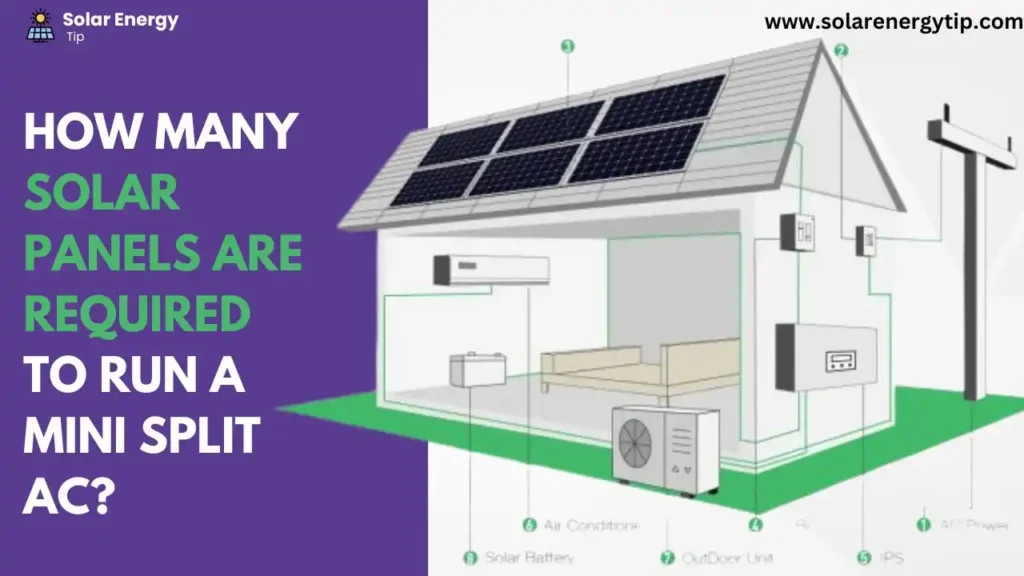
Finding effective and environmentally responsible ways to cool our houses becomes a primary priority as the oppressive summer heat settles upon us.
I wondered, “How many solar panels do I need to run a mini split air conditioning system?” during one particularly oppressive summer.
A 12,000 BTU mini split will typically require 3 to 5 solar panels.
In one example, three to five solar panels would be required for a 12,000 BTU mini split with an annual energy consumption of about 2,000 kWh.
A table shows the approximate number of solar panels needed to run a mini-split system in the USA based on system size and typical solar panel wattages.
This table is an estimate only.
Assumptions:
- Mini-split system power consumption: 1.5 kilowatts
- Average solar panel wattage: 300 watts
| Mini-Split System Size | Power Consumption (kW) | Number of Solar Panels (Approximate) |
|---|---|---|
| 9,000 BTU | 1.5 kW | 2-3 |
| 12,000 BTU | 2.0 kW | 3-5 |
| 18,000 BTU | 3.0 kW | 5-7 |
| 24,000 BTU | 4.0 kW | 7-9 |
| 30,000 BTU | 5.0 kW | 11-12 |
Here is my favourite 12000BTU mini split, which I suggest to you.
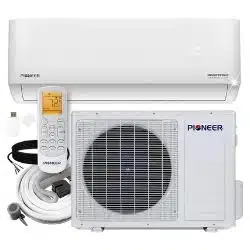
Pioneer® Diamante Ultra 12,000 BTU
Ductless Mini-Split Inverter++
- Ultra-quiet operation
- Ultra capable version
- Wi-Fi enabled to program
- Managing functionality via the free Pioneer app
How Many Solar Panels Do I Need to Run a Mini Split? With Formula Ultimate Guide
The air conditioner’s power demand, solar panel efficiency, sun irradiation, and system losses must be considered to calculate the ideal quantity of solar panels.
Formulas and examples are below:
Determine the Mini Split AC’s Power Consumption:
Determine how much electricity your mini split air conditioner uses daily in watts or kilowatts.
The mini split air conditioner label or specification sheet usually contains this information.
Example: Suppose your mini split AC has a power consumption of 1,500 watts (1.5 kW).
Estimate Daily Energy Requirement:
To determine how much energy the mini split AC needs daily, multiply its power use by the hours it runs daily. The thermostat’s use and temperature may vary in this estimate.
Example: If your mini split AC runs for 8 hours per day:
Daily Energy Requirement = Power Consumption × Operating Hours Daily Energy
Requirement = 1.5 kW × 8 hours = 12 kWh (kilowatt-hours)
Account for Solar Panel Efficiency:
The effectiveness of the solar panels you intend to install should be considered. Solar power efficiency is estimated by how much power it generates from sunshine.
Example: Assuming your solar panels have an efficiency of 20% (0.20).
Consider System Losses:
Inverter efficiency losses, wire losses, shadowing, and dirt on the panels should all be considered. Calculate the percentage of these losses.
Example:
Considering system losses of 15% (0.15).
Estimate Solar Irradiation:
Solar irradiation is a location’s solar energy, measured in kWh/m2/day. Location, season, and climate affect sun irradiation.
Solar maps or local solar resources help you determine regional solar irradiation.
Example: Let’s assume the estimated solar irradiation in your location is 5 kWh/m²/day.
Calculate the Number of Solar Panels:
The following calculation can be used to estimate how many solar panels will be needed to run a mini split AC.
Number of Solar Panels = (Daily Energy Requirement) / (Solar Panel Efficiency × Solar Irradiation × System Losses)
Example:
Filling in the values from the last steps:
Number of Solar Panels = 12 kWh / (0.20 × 5 kWh/m²/day × 0.15)
Number of Solar Panels ≈ 12 kWh / 1 kWh/m²/day ≈ 12 solar panels
In this example, you would need approximately 12 solar panels to meet the daily energy requirement of the air conditioner, considering the given specifications, solar panel efficiency, system losses, and estimated solar irradiation.
A professional solar installer can evaluate your unique situation, consider additional variables, and provide accurate sizing for your solar panel system to meet the energy demands of the air conditioner efficiently.
It is critical to remember that the computations’ results only approximate the value.
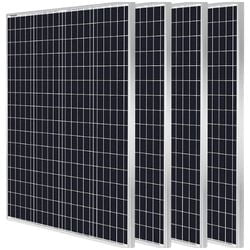
HQST 12V Monocrystalline Solar Panel
400 Watt
- Easy Installation
- Comes with a junction container
- Each of our solar panels is tested and examined
Factors to Consider for How Many Solar Panels to Run a Mini Split?
To answer this question, here I discuss some factors that affect solar panel numbers to run a Mini Split.
These include,
- Energy Efficiency of Mini Splits
- Climate and Weather Conditions
- Energy Consumption of the Mini Split
- Solar Panel Efficiency
- Sunlight Availability and Geographic Considerations
- Solar Panel Tilt/Orientation
- Considering Battery Storage
- Roof Orientation and Space
Understanding these factors will help you accurately assess and avoid under or over-sizing your solar panel system for your mini split.
Energy Efficiency of Mini Splits
Solar panel requirements depend on your mini split system’s energy efficiency rating.
High SEER and HSPF values are desirable. These ratings represent system cooling and heating efficiency.
Higher SEER and HSPF ratings reduce energy use.
HSPF – Heating Seasonal Performance Factor.
SEER – Seasonal Energy Efficiency Ratio
Climate and Weather Conditions
Your mini split’s energy needs depend on the weather.
Hotter climates require more cooling and heating energy. Calculate solar panel needs based on seasonal fluctuations and peak consumption.
Energy Consumption of the Mini Split
Your mini-split system uses kWh. Consult the system’s specifications or manufacturer for energy usage.
This information is essential for evaluating the amount of solar panels needed to power your mini-split.
Solar Panel Efficiency
Solar panel efficiency influences mini-split system power requirements.
Higher-efficiency panels turn more sunshine into energy, increasing power output.
High-efficiency panels enhance energy production and reduce panel count.
Sunlight Availability and Geographic Considerations
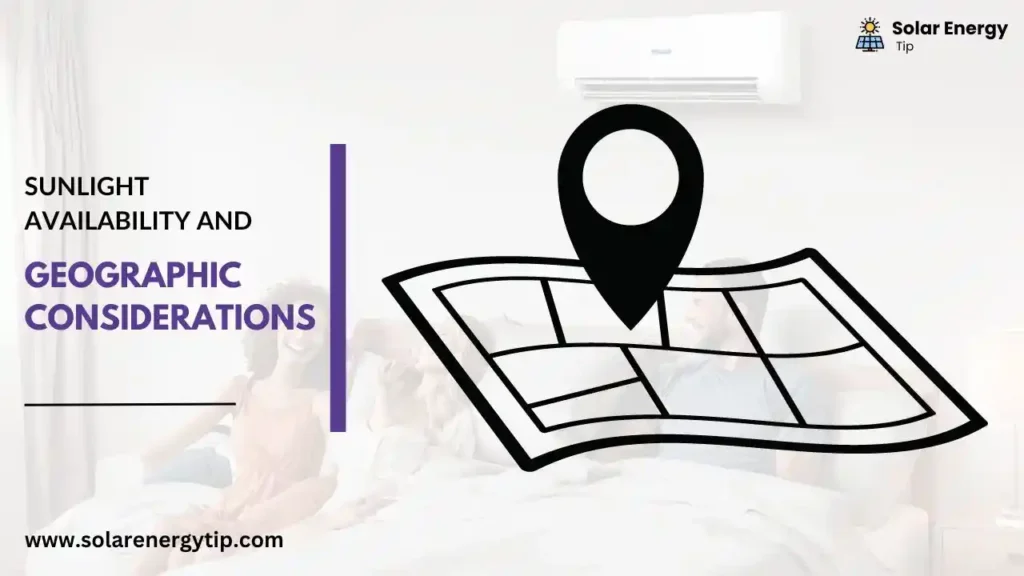
The installation position determines solar energy potential.
USA regions vary in sunlight intensity, duration, and weather.
In places with more cloud cover or less sunlight, more panels may be needed to generate as much solar energy.
Sun zones, based on average sun radiation, divide the United States. Zone 1 is the sunniest, and Zone 7 is the least.
Solar irradiance maps or local solar professionals can establish your solar zone.
Let’s examine solar potential by location and the number of solar panels needed to power a mini-split.
| Solar Zone | States Included | Solar Potential | Minimum Mini Split Capacity (BTU) | Required Number of Solar Panels |
|---|---|---|---|---|
| Zone 1 | California, Arizona, Nevada | High | 12,000 BTU | 2-3 solar panels |
| Zone 2 | New Mexico, Texas (Western) | Moderate to High | 12,000 BTU | 3-4 solar panels |
| Zone 3 | Texas, Florida, Midwest | Moderate | 12,000 BTU | 3-4 solar panels |
| Zone 4 | Kansas, Missouri, Illinois | Moderate | 12,000 BTU | 4-5 solar panels |
| Zone 5 | New York, Pennsylvania, New England | Moderate | 12,000 BTU | 4-5 solar panels |
| Zone 6 | North Dakota, Minnesota, Wisconsin | Moderate to Low | 12,000 BTU | 5-6 solar panels |
| Zone 7 | Alaska, Pacific Northwest | Low | 12,000 BTU | 5-6 solar panels |
Solar Panel Tilt/Orientation
Solar panel orientation affects energy generation. Panels should face true south (Northern Hemisphere) or true north (Southern Hemisphere) to optimize sunlight.
Optimize energy capture by matching the tilt angle to the installation site’s latitude.
Deviating from these ideal angles may reduce power output and panel count.
The recommended solar panel tilt and orientation for several US locations are shown in the table below:
| Region | Recommended Tilt Angle | Recommended Orientation |
|---|---|---|
| Northeast | 30° to 40° | South |
| Mid-Atlantic | 30° to 40° | South |
| Southeast | 25° to 35° | South |
| Midwest | 30° to 40° | South |
| Southwest | 20° to 30° | South |
| Northwest | 30° to 40° | South |
| West Coast | 20° to 30° | South |
Roof Orientation and Space
Solar panel placement and roof orientation are critical.
Panels should face south to enhance daytime light exposure. To fit the necessary panels, the roof must be unobstructed.
Considering Battery Storage
Solar panels provide electricity during daylight, but what happens at night or on overcast days?
Battery storage lets you store energy at peak output and use it when the sun isn’t shining.
This keeps your mini split powered, increasing energy independence and decreasing grid dependence.
Local Regulations:
Local solar legislation and incentives must be researched. Some jurisdictions ‘ tax incentives, subsidies, and net metering programs reduce solar panel installation costs.
These criteria can help you decide how many panels your mini split needs.
What is The Best Solar-Powered Mini Split Unit?
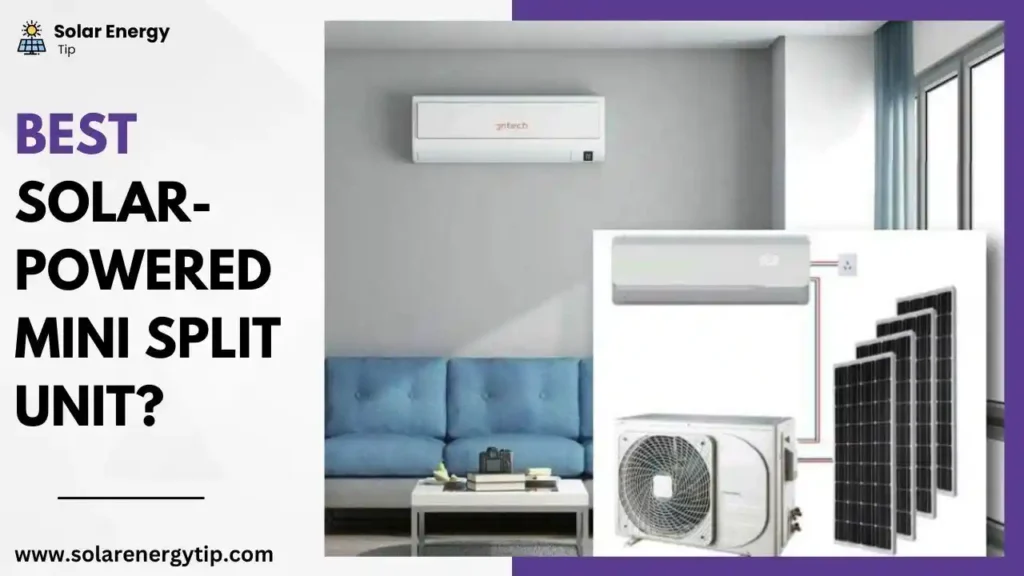
After knowing the number of solar panels to run a Mini Split, I have given below great examples of how you will install mini-split solar panels in your home or place.
Jntech 12000BTU Solar ACDC is the Best Solar Powered Mini Split.
The Jntech 12000BTU Solar ACDC mini-split unit has a SEER rating of 22, making it an energy-efficient choice.
It can be used year-round as a heat pump and AC. Solar power allows it to provide sustainable cooling and heating for off-grid dwellings.
Its low cost makes it appealing to energy savers.
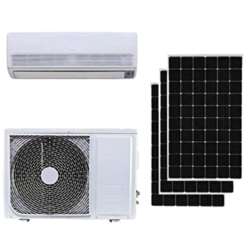
Jntech 12000BTU Solar ACDC
Solar Generator
- Model: 12000BTU Solar ACDC
- Inverter Ductless Mini Split Air Conditioner with Heater
- Cooling Capacity: 12000 BTU
Pros:
Cons:
How Many Solar Panels Do I Need to Run a 1-Ton Mini Split?
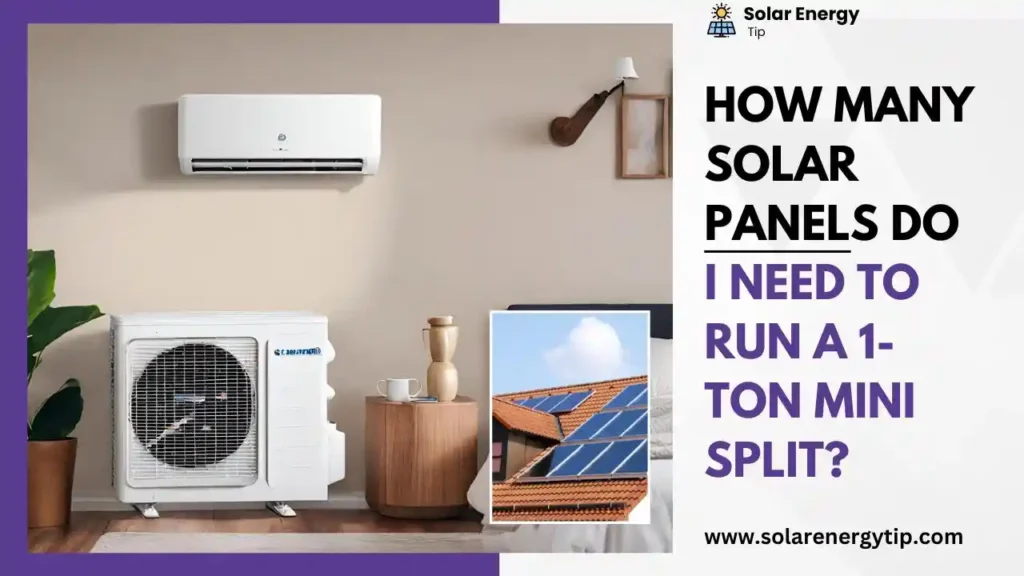
The considerations will determine how many solar panels will be needed to power a 1-ton mini-split system in the United States.
Based on an average power demand of 1,200-1,500 watts for a 1-ton mini-split, usual solar panel efficiency, and US sun irradiation, you would need 4-8 solar panels.
Visiting a nearby solar contractor would be beneficial to acquire precise quotations based on your location and your system’s needs.
How Many Solar Panels to Run a 12000 BTU Mini Split
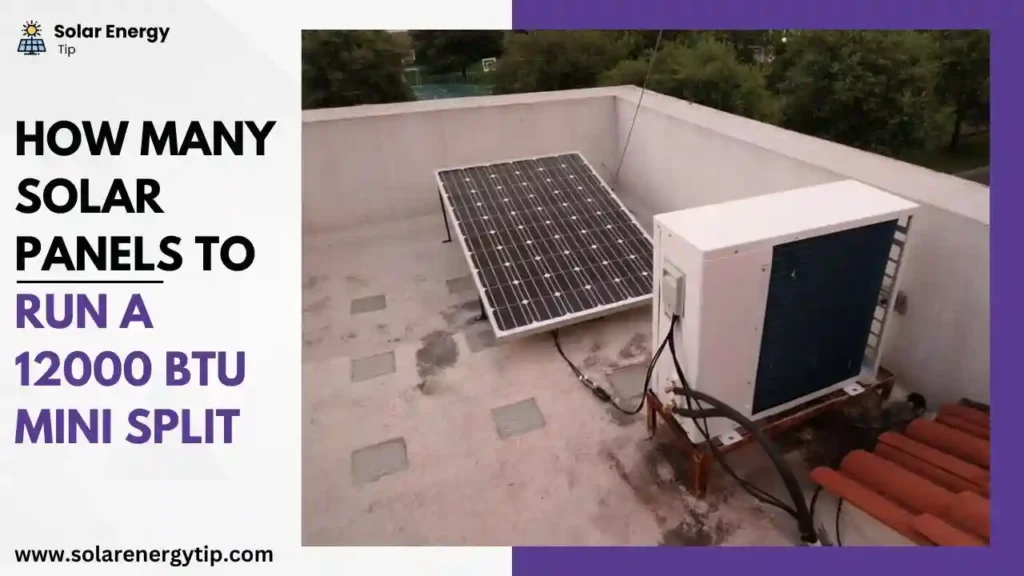
A 12,000 BTU mini-split AC in the US requires 4–8 solar panels.
We calculated this using national averages for solar panel efficiency and typical household electricity demand of 1,000 to 1,500 watts.
These estimates depend on solar panel efficiency, local sun irradiation, and energy needs.
A solar professional can provide a more accurate assessment based on your location and system demands.
Mini Split 110v VS 220v When Using Solar Panels
Here, we will also get information about the 110V and 220V mini split and how it is used.
110V Mini-Split System: US home voltage powers 110V mini-split systems. It uses 110V, the standard household electricity. Inverters convert solar panel power to 110V mini-split system voltage.
220V Mini-Split System: A 220V system requires 220V electricity. This technology may be more energy-efficient for bigger cooling/heating capacity. An inverter to convert solar power to 220V for a 220V mini-split system.
Consider these variables while choosing a 110V or 220V solar panel mini-split system:
Power Consumption: Determine the mini-split’s power consumption. High-capacity systems may need 220V power.
Solar Panel System: For 110V or 220V mini-split systems, ensure your solar panel system is big enough. Consult a solar installer to determine your energy needs and recommend a system.
Select a mini-split system-compatible inverter. Inverters that convert DC power to 110V AC power are needed for 110V systems. A DC-to-220V inverter is needed for a 220V system.
Explain How a Hunless Generator Powered by Solar Panels Can Run a Ductless Mini-Split AC Unit
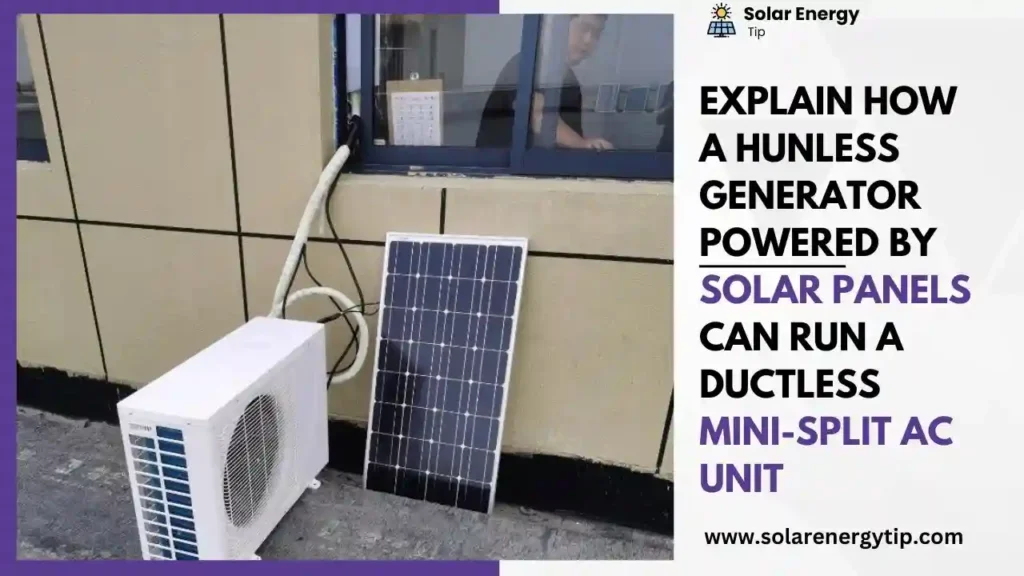
Solar panels power a hybrid generator that powers ductless mini-split AC units.
An inverter converts DC solar power to AC.
To maintain electricity, batteries can be added. The AC unit has an exterior condenser and an internal air handler.
Solar panels, inverters, and energy storage systems provide the AC unit with AC electricity.
This system allows clean, renewable energy use, minimizes fossil fuel use, and lowers energy prices and environmental effects.
FAQs
How much does installing solar panels for a mini-split system cost?
Solar panel installation for a mini-split system depends on panel number, system capacity, location, and installation complexity. Solar installation experts can provide realistic cost estimates based on your needs.
Can solar panels, including the mini-split system, generate enough power for my home?
Yes, Solar panels, including the mini split system, can power your home. The number of panels needed depends on energy usage and system size.
Are there any government incentives or rebates for installing solar panels?
Installing solar panels is often subsidized. Check local programs for cash incentives to offset installation expenses.
Can I use solar panels to power appliances besides my mini-split system?
Yes, solar panels can power home appliances. Installing a large solar energy system can lessen your grid dependence and power much of your household’s electricity.
Conclusion
Solar energy can power your remote mini-split system sustainably. The quantity of solar panels needed depends on micro split energy efficiency, climate, energy usage, and efficiency.
Using proper planning, installation, and maintenance, you can use clean, affordable energy to cool or heat your home.

